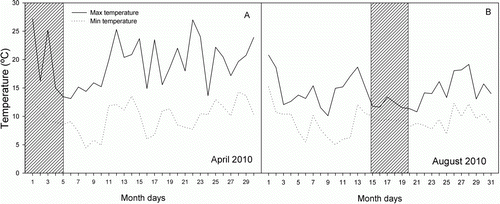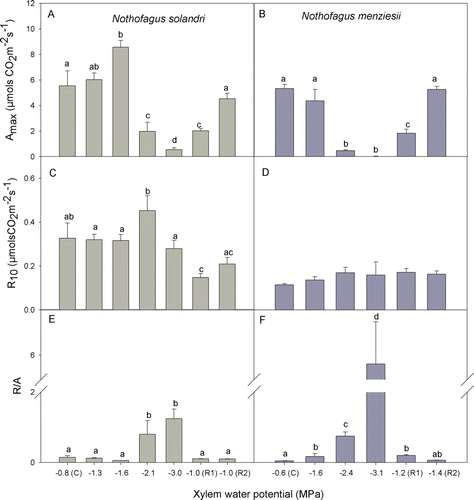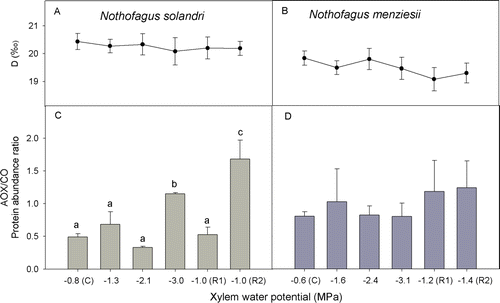Figures & data
Figure 1 Maximum and minimum daily temperatures at the University of Canterbury study site (Geography Department, University of Canterbury). The values correspond to late summer (April 2010) and winter (mid-August 2010). The hatched band indicates the days of measurement.

Table 1 Physiological, respiratory and photosynthetic parameters for leaves of Nothofagus solandri and Nothofagus menziesii during late summer and winter.
Figure 2 Relative abundance of alternative oxidase (AOX) and cytochrome oxidase (COX) proteins during summer and winter for Nothofagus solandri and Nothofagus menziesii in the seasonal study. Values shown are mean±SEM. Two-way analysis of variance was performed including the factors species (P<0.001) and season (P≤0.05). Different lower case letters show statistical differences (Fisher least significant difference test).

Figure 3 Variation in gas exchange parameters in Nothofagus solandri and Nothofagus menziesii during drought treatment and recovery. Dark respiration at 10°C in response to water-deficit treatment and subsequent re-watering was calculated from fitted temperature–response curves using a modified Arrhenius equation (A, B). A max represents the maximum CO2 assimilation measured at 20°C and light saturation (C, D). Foliar R/A is an indicator of the carbon balance at the foliar level (E, F). Values shown are mean±SEM. One-way analysis of variance (P≤0.05) was performed where the factor was xylem water potential during treatment being C (control) and R1-2 (recovery). Different lower case letters show significantly different means (Fisher least significant difference test).

Table 2 Dark respiration parameters calculated from fitted temperature response curves using a modified Arrhenius equation for leaves of Nothofagus solandri and Nothofagus menziesii during water deficit treatment and recovery.
Figure 4 Changes in oxygen isotope discrimination (A, B) and protein abundance ratio of alternative oxidase and cytochrome oxidase (AOX/COX) (C, D) during water deficit treatment and recovery for Nothofagus solandri and Nothofagus menziesii. Values shown are mean (± SE). One-way analysis of variance (P≤0.05) was performed where the factor was xylem water potential during treatment being C (control) and R1-2 (recovery). Different lower case letters show significantly different means (Fisher least significant difference test).
